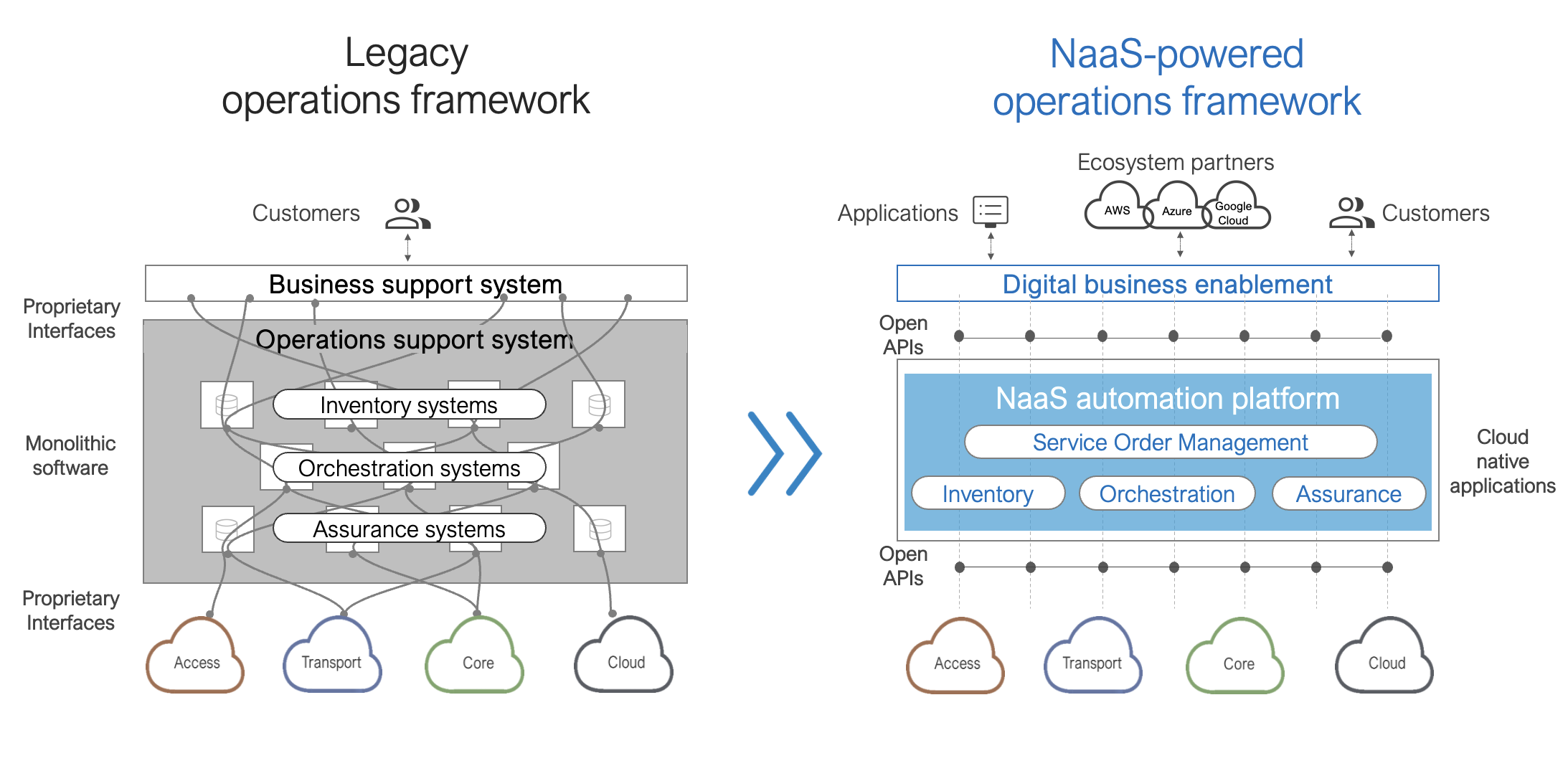What is network as a service?
Network as a service (NaaS) is a standardized operational framework developed by the TM Forum that helps communications service providers (CSPs) provide on-demand services, reduce order-to-service OPEX, and accelerate network monetization and ROI.
NaaS overcomes the deficiencies associated with traditional operations environments that CSPs use to create, deliver, and monitor connectivity services. Issues include highly customized legacy operations support systems (OSS) that use proprietary interfaces and rely on manual intervention in the order-to-service process—making service activation slow and expensive, especially when a service path crosses multiple network domains.
In contrast, NaaS introduces a layered framework that uses standardized APIs between the OSS (or services management layer), the business support system (BSS), and the underlying network domains. This approach enables zero-touch, API-driven, on-demand connectivity services—including short-to-medium–term connections across enterprises, private data centers, public clouds, interexchange nodes, and partner locations.

NaaS benefits
A new generation of services. NaaS helps CSPs maximize the return on their massive network investments with innovative high-value services that are too operationally complex to design and deliver with traditional operational processes. Examples include dynamic 5G network slice–based services end to end across radio access network (RAN), transport, and 5G core domains; connectivity as a service (aka bandwidth on demand) for wave, optical ethernet, and IP-based services; and multi-vendor software-defined WAN (SD-WAN) and secure access service edge (SASE) solutions.
Cloud-like customer experiences. Unlike traditional static services that take days or weeks to activate and involve long-term contractual commitments, NaaS enables immediate service activation that lets enterprise and wholesale customers quickly respond to unforeseen business opportunities. In fact, CSPs can even let customers use a self-service portal to activate and terminate their services on demand—with flexible time- and usage-based consumption models—similar to how they consume cloud-based services.
Unleashing digital ecosystems. While NaaS was pioneered by the TM Forum to enable on-demand services, other industry consortia have extended NaaS to a broader set of use cases. For example, MEF Lifecycle Service Orchestration (LSO) APIs and GSMA Network APIs allow CSPs to expose their network capabilities to their digital ecosystem partners—such as hyperscalers, systems integrators, and application developers—to facilitate the creation of advanced applications and services. This exposure lets CSPs explore new business models and tap new revenue streams, which the analyst firm McKinsey and Co. estimates could reach $300 billion by 2030.1
Blue Planet and NaaS
Blue Planet is a recognized leader in NaaS. We combine productized inventory, orchestration, and assurance automation applications with a state-of-the-art AI Studio built on the industry's first cloud-native platform to provide the end-to-end services management layer of the NaaS hierarchy.
Blue Planet has all the building blocks of a modern NaaS-optimized OSS, including:
- Dynamic inventory for real-time visibility into all network resources and services
- TM Forum Open API support for standardized communications
- A modular, cloud-native design that easily integrates network APIs
- Service order management and declarative orchestration that translate order intent into zero-touch resource provisioning and service activation workflows
- AI integration into all phases of the service lifecycle from order intake to network planning and service design, through AI-guided orchestration and assurance
In summary
The unique ability to modernize operations and support business model evolution positions NaaS as the foundation for strategic telco-to-techco transformation initiatives. It’s easy to see why CSPs are embracing NaaS to modernize their OSS, de-risk new service and technology introductions, reduce OPEX, and open new revenue opportunities.
As you plot your NaaS journey, please consider Blue Planet as an ideal collaborator. We have extensive NaaS experience gained from the earliest catalysts through cutting-edge deployments of productized NaaS-centric solutions at industry-leading global CSPs. We are eager to collaborate with you and help you achieve your technical and business goals.
1McKinsey and Co., “What It Will Take for Telcos to Unlock Value From Network APIs,” Cristina Dexeus, Ferry Grijpink, et al., February 2024
